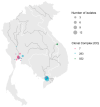Geographical, Temporal and Host-Species Distribution of Potentially Human-Pathogenic Group B Streptococcus in Aquaculture Species in Southeast Asia
- PMID: 37111411
- PMCID: PMC10146238
- DOI: 10.3390/pathogens12040525
Geographical, Temporal and Host-Species Distribution of Potentially Human-Pathogenic Group B Streptococcus in Aquaculture Species in Southeast Asia
Abstract
Group B Streptococcus (GBS) is a major pathogen of humans and aquatic species. Fish have recently been recognized as the source of severe invasive foodborne GBS disease, caused by sequence type (ST) 283, in otherwise healthy adults in Southeast Asia. Thailand and Vietnam are among the major aquaculture producers in Southeast Asia, with GBS disease reported in fish as well as frogs in both countries. Still, the distribution of potentially human-pathogenic GBS in aquaculture species is poorly known. Using 35 GBS isolates from aquatic species in Thailand collected from 2007 to 2019 and 43 isolates from tilapia collected in Vietnam in 2018 and 2019, we have demonstrated that the temporal, geographical, and host-species distribution of GBS ST283 is broader than previously known, whereas the distribution of ST7 and the poikilothermic lineage of GBS are geographically restricted. The gene encoding the human GBS virulence factor C5a peptidase, scpB, was detected in aquatic ST283 from Thailand but not in ST283 from Vietnam or in ST7 from either country, mirroring current reports of GBS strains associated with human sepsis. The observed distribution of strains and virulence genes is likely to reflect a combination of spill-over, host adaptation through the gain and loss of mobile genetic elements, and current biosecurity practices. The plastic nature of the GBS genome and its importance as a human, aquatic, and potentially foodborne pathogen suggests that active surveillance of GBS presence and its evolution in aquaculture systems may be justified.
Keywords: ST283; Streptococcus agalactiae; host-adaptation; zoonosis.
Conflict of interest statement
The authors declare no conflict of interest.
Figures


References
-
- Da Cunha V., Davies M.R., Douarre P.E., Rosinski-Chupin I., Margarit I., Spinali S., Perkins T., Lechat P., Dmytruk N., Sauvage E., et al. Streptococcus agalactiae clones infecting humans were selected and fixed through the extensive use of tetracycline. Nat. Commun. 2014;5:4544. doi: 10.1038/ncomms5544. - DOI - PMC - PubMed
-
- Gonçalves B.P., Procter S.R., Paul P., Chandna J., Lewin A., Seedat F., Koukounari A., Dangor Z., Leahy S., Santhanam S., et al. Group B Streptococcus infection during pregnancy and infancy: Estimates of regional and global burden. Lancet Glob. Health. 2022;10:e807–e819. doi: 10.1016/S2214-109X(22)00093-6. - DOI - PMC - PubMed
-
- Skoff T.H., Farley M.M., Petit S., Craig A.S., Schaffner W., Gershman K., Harrison L.H., Lynfield R., Mohle-Boetani J., Zansky S., et al. Increasing burden of invasive group B streptococcal disease in nonpregnant adults, 1990–2007. Clin. Infect. Dis. 2009;49:85–92. doi: 10.1086/599369. - DOI - PubMed
-
- Collin S.M., Shetty N., Guy R., Nyaga V.N., Bull A., Richards M.J., van der Kooi T.I., Koek M.B., De Almeida M., Roberts S.A., et al. Group B Streptococcus in surgical site and non-invasive bacterial infections worldwide: A systematic review and meta-analysis. Int. J. Infect. Dis. 2019;83:116–129. doi: 10.1016/j.ijid.2019.04.017. - DOI - PubMed
LinkOut - more resources
Full Text Sources

